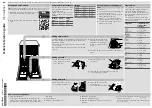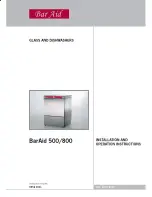
9
Clear the water lines
Run water through both faucets and inlet hoses, into a bucket or
laundry tub, to get rid of particles in the water lines that might
clog the inlet filter washers. The water should be clean, especially
where the system is new or has been left unused for a length of
time.
Connect the inlet hoses to the washer
1. Insert the filter washer (supplied) into the coupling of the hose
fitting elbow, before connecting the water inlet hose to the
valve on the back of the washer.
2. Attach the hose with the red stripe to the HOT (right) inlet
valve on the washer. Screw on coupling by hand until it is
seated on the washer. Make sure the hose connection is
tight.
NOTE: Do not overtighten. Damage to the valves can result.
3. Attach the other hose to the COLD water (left) inlet valve.
Screw on coupling by hand until it is seated on the washer.
Make sure the hose connection is tight.
NOTE: Do not overtighten. Damage to the valves can result.
Check for leaks
Turn on the water faucets and check for leaks. A small amount of
water might enter the washer. You will drain this later.
NOTE: Replace inlet hoses after 5 years of use to reduce the risk
of hose failure. Record hose installation or replacement dates for
future reference.
■
Periodically inspect and replace hoses if bulges, kinks, cuts,
wear, or leaks are found.
Level the Washer
Properly leveling your washer averts excessive noise and
vibration.
1. Drape the power cord over the console.
2. Move washer to its final location. Remove any cardboard
used to move washer.
3. Check that the washer is level.
■
Check side to side and back to front by lining up the level
as shown in the following illustration.
4. If the washer is not level, prop up the front of the washer with
the wood block and adjust the feet up or down as necessary.
If the washer is against a wall, move the washer out slightly
before tipping back. Repeat this step until washer is level.
Complete Installation
1. Check the electrical requirements. Be sure that you have the
correct electrical supply and the recommended grounding
method. See “Electrical Requirements.”
2. Check that all parts are now installed. If there is an extra part,
go back through the steps to see which step was skipped.
3. Dispose of or recycle all packaging materials. Keep the
shipping bolts, spacers, and transport bars for use if the
washer should be transported.
4. Check that all the water faucets are completely on.
5. Check for leaks around faucets and inlet hoses.
6. Plug into a grounded 3 prong outlet.
7. Read “Washer Use.”
8. To test and to clean your washer, measure and add
¹⁄₂
the
normal recommended amount of High Efficiency (HE)
detergent to the washer. Close the door. Select any cycle,
and then press START. Allow it to complete one whole cycle.
A. Cold water inlet valve
B. Hot water inlet valve
B
A
Electrical Shock Hazard
Plug into a grounded 3 prong outlet.
Do not remove ground prong.
Do not use an adapter.
Do not use an extension cord.
Failure to follow these instructions can result in death,
fire, or electrical shock.
WARNING
Summary of Contents for LHW0050P
Page 21: ...21 Notes ...










































